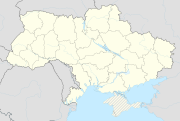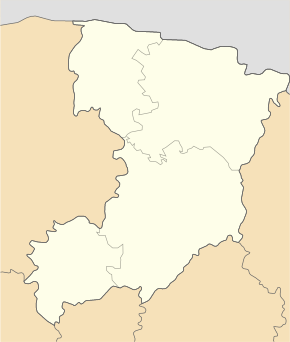Tuchyn
| Tuchyn | ||
| Тучин | ||

|
|
|
| Basic data | ||
|---|---|---|
| Oblast : | Rivne Oblast | |
| Rajon : | Hoshcha district | |
| Height : | 178 m | |
| Area : | 6.616 km² | |
| Residents : | 2,540 (2001) | |
| Population density : | 384 inhabitants per km² | |
| Postcodes : | 35415 | |
| Area code : | +380 3650 | |
| Geographic location : | 50 ° 42 ' N , 26 ° 34' E | |
| KOATUU : | 5621288401 | |
| Administrative structure : | 2 villages | |
| Address: | вул. Староміська 2 35415 с. Тучин |
|
| Statistical information | ||
|
|
||
Tutschyn ( Ukrainian Тучин ; Russian Тучин Tutschin , German Tutschin , Polish Tuczyn , Yiddish טוטשין) is a village in the western Ukrainian Oblast Rivne with 2,540 inhabitants (2001). It is located in Hoschtscha Rajon in historical Volhynia, about 18 km east of Rivne on the Horyn River , and the village of Poliwzi (Полівці) also belongs to the district of the same name .
Historical structure
Tuchyn was a very complex city. Before World War II , there was a large Jewish, Polish, and Ukrainian population. In 1590 a Roman Catholic parish was founded, which encompasses the surrounding villages Buhryński Majdan, Cecylówka, Drozdów, Horbów, Jadzin, Karczemka, Korościatyn, Krąglik, Kryniczka, Kudranka, Kuty Zalesie, Leonówka, Lucynów, Mikulin, Niespodzianka: I: I, III ; Piotrowica, Podobanka, Pustomycki Majdan, Pustomyty Ryświanka, Rzeczyca, Sienne, Smolarnia, Sobówka dwór, Urszulin, Woronów, Woskodawy and Zalanka. In 1938 the Catholic community had 2,660 members, mostly from Poland.
There was also a significant German population group before World War II. It had settled mainly in the 1860s and belonged mainly to the Evangelical Lutheran denomination, looked after by the community in Zhytomyr . In 1888 the Lutheran congregation was founded in Tutschyn. It reached its climax before the First World War when it counted over 25,000 Germans among its members in over 80 villages in a large area around Tutschyn, even if no church was built until 1929. Membership fell sharply before World War I when many Germans emigrated to North America . In the period between the world wars, the community still had about 6,000 members.
history
Tutschyn was the ancestral seat of the Polish noble family Siemaszko . In 1650 the town was owned by the Daniłłowicz family , later by the Lubomirskis and finally by the Walewskis from the 18th century until the outbreak of the Second World War . The Stanisław Lubomirski Foundation built two wooden churches in the city in 1711 and 1730. The Walewskis built a classical church in 1796 . Before the Second World War, Tutschyn was an important city in the district with a strong Jewish, Polish, Ukrainian and partly German population.
After the occupation by the Soviet Union in September 1939, the town's status was revoked, and since then the rather large Tutschyn has only been a village. Between 1940 and 1959, the place was also the center of the Rajon Tutschyn Rajon , which then became part of today's Hoschtscha Rajon.
The Jewish uprising in Tuchyn
Before the Second World War, around 3,000 Jews lived in Tuchyn. After learning of the dissolution of the Jewish ghetto in Rivne, it was decided to put up resistance to the Nazis . On Tuesday evening, September 23, 1942, a blockade was erected at the Tuchyn ghetto. The leaders of the uprising sounded the alarm and the fighting groups took their positions. On September 24th, German forces and Ukrainian auxiliaries advanced against the demarcation of the ghetto. When the resistance forces gave the signal, the buildings of the ghetto and the German department stores on its edge were set on fire. The fighting groups opened fire, broke through the gates of the ghetto and drove the population to flight. Around 2,000 people - around two thirds of the ghetto population - fled to the forest with women, children and the elderly under smoke and gunfire. The flames raged for the rest of the day and part of the following day, and the gunfire continued. Some German and Ukrainian auxiliary police officers were killed. A third of the ghetto population fell, including all the fighters.
The uprising ended on Saturday, September 26th, when the leading resistance members surrendered themselves to the Germans because they could not bear the conditions in the woods. Half of those who escaped were captured and murdered within three days. About 300 women with children who could not survive in the forest returned to Tuchyn and were shot. Many of those who remained died, others were handed over or murdered by local farmers. Some younger people joined the partisans and were killed in fighting. Of the 3,000 Jews from Tuchyn, only 20 were alive when it was liberated on January 16, 1944.
Web links
- Tuczyn . In: Filip Sulimierski, Władysław Walewski (eds.): Słownik geograficzny Królestwa Polskiego i innych krajów słowiańskich . tape 12 : Szlurpkiszki – Warłynka . Walewskiego, Warsaw 1892, p. 606 (Polish, edu.pl ).
- Tutschyn business register from 1923
- The uprising in the Tutschyn ghetto on September 24, 1942
- History of the Tutschyn Lutheran Congregation
- The events in Tutschyn during the Second World War ( Memento from July 31, 2007 in the Internet Archive )


